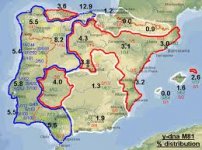martiko
martiko
- Messages
- 213
- Reaction score
- 10
- Points
- 0
- Ethnic group
- european : basqueR1b/IberianI2b
- Y-DNA haplogroup
- R1b-DF100
- mtDNA haplogroup
- T1a1
therefore you should not read any article but only the serious articles, verbs in Basque are systematically used with an infinitive form accompagne of an auxiliaire and ergative. This is also case of ancient language IE.
Nowadays it is risked to maintain that Basque is or is not a language IE.
The linguists said that it faillait 3000 years in a language so that it is very hard transformed, the bulk is to know the age of the most ancient language at the origin of the group IE, therefore if they are held in reasoning premiiers IE is less than 3000 years old? By knowing that both languages would have diverged chacunes during 3000 years they succeed in multiplying linguistic distance by two.
Nothing makes it on topic cannot be asserted, and I am surprised to see so many people writing affirmations, while the best of everything linguist asserts nothing and to name them, no language can be nowadays compare in Basque but it is well necessary to admit that the languages which get closer most languages IE are.
My purpose is not to say that Basque is IE but of resting a question having accepted poor answers, I wait for an answer to the realistic or logical minimun.
Nowadays it is risked to maintain that Basque is or is not a language IE.
The linguists said that it faillait 3000 years in a language so that it is very hard transformed, the bulk is to know the age of the most ancient language at the origin of the group IE, therefore if they are held in reasoning premiiers IE is less than 3000 years old? By knowing that both languages would have diverged chacunes during 3000 years they succeed in multiplying linguistic distance by two.
Nothing makes it on topic cannot be asserted, and I am surprised to see so many people writing affirmations, while the best of everything linguist asserts nothing and to name them, no language can be nowadays compare in Basque but it is well necessary to admit that the languages which get closer most languages IE are.
My purpose is not to say that Basque is IE but of resting a question having accepted poor answers, I wait for an answer to the realistic or logical minimun.


